

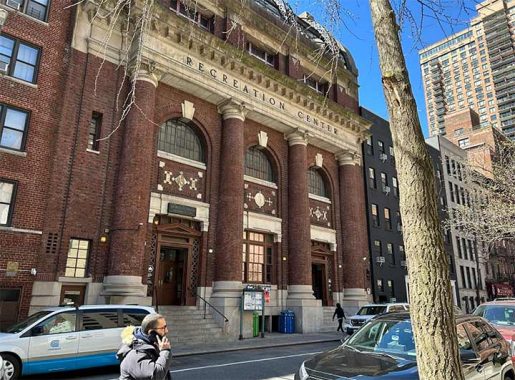
In 2015, Kevin visited the East 54th Street Recreation Center in Turtle Bay, documenting its Beaux Arts architecture. Since then, it was renamed for Constance Baker Motley, continuing its role as an “indoor park” with a gym, indoor sports, running track, and swimming pool. Ahead of its landmarking in 2011, the city published a detailed report on its history. Next to the rec center is Neighborhood Playhouse School, where actors learn their craft.
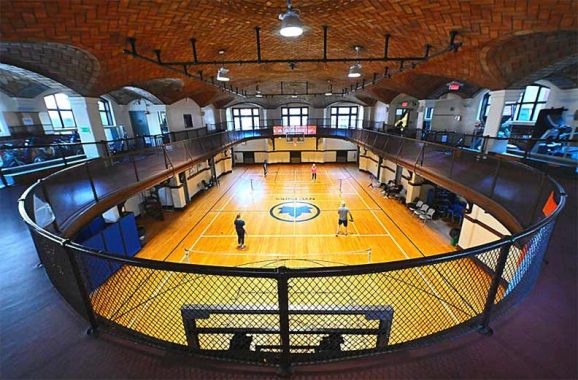
Across this city, a family of historic buildings share the distinction of having Guastavino tiles. Along with this rec center, others include the Great Hall at Ellis Island, Queensboro Bridge, City Hall loop subway station, and the south arcade of the Municipal Building.
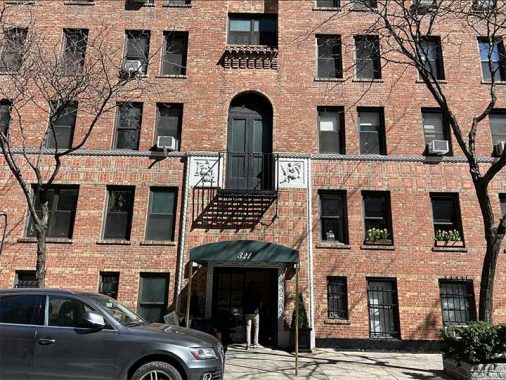
After an indoor run, I went to the FDR Post Office a block to the west, and documented the architecture and artworks on the way. 321 East 54th Street is an Art Deco design by Mortimer Freehoff. He has a similar design at the Medical Arts Building in Brooklyn Heights. This co-op has a figure on the right holding the caduceus, perhaps in expectation of doctors having their offices here.
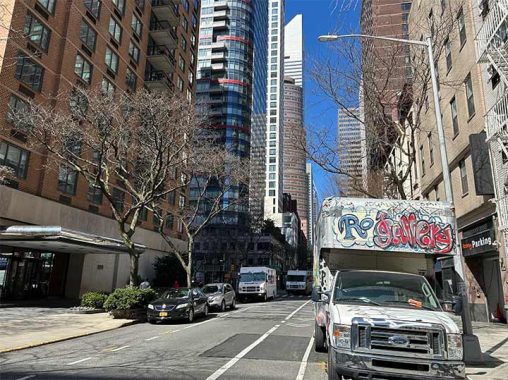
The Lipstick Building and Citigroup Center are the recognizable giants in the view west, but this being Forgotten-NY, I was curious about the circular residential tower at the corner of 54th Street and Second Avenue. Completed in 1990, its patterns of blue and red inspired its name, The Mondrian. The Dutch artist is famous for non-objective paintings inspired by Manhattan’s street grid. There is also a hotel on Park Avenue that carries his name. Fleeing from the Nazis, Piet Mondrian lived his last years in New York and was buried at Cypress Hills Cemetery.
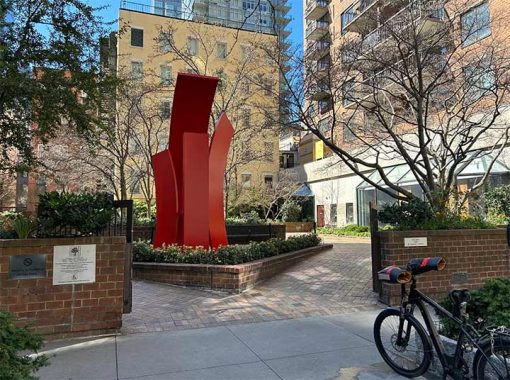
Before crossing Second Avenue, on the same block as the rec center is a POPS- privately owned public space, which is a park open to the public in exchange for the developer’s right to build bigger and taller on the property. Connaught Tower’s Park has Alexander Liberman’s 1979 work titled Accord. When the Nazis invaded France, he served in the Army, but after the surrender his family was lucky to escape, landing in New York in 1941. He initially worked as a photographer at Vogue Magazine, documenting fellow artists, before building his reputation in sculptures.

On the next block to the west, Vornado’s massive 909 Third Avenue has the modernist cheese grate look, built atop a boxy pedestal. The owner gives a positive spin to its appearance: “The building’s architects, Emery Roth & Sons, achieved a kinetic sentiment in the design of the 1.3 million square foot monolithic structure through a bold waffle pattern that distinguishes the property.”
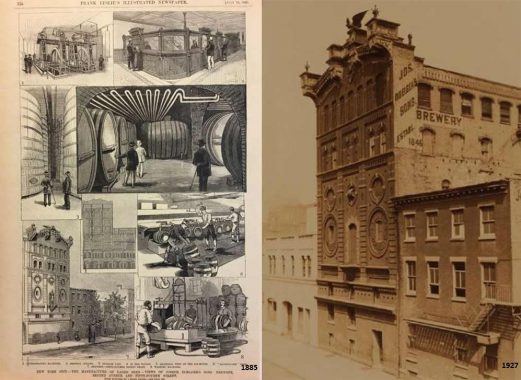
Looking back in time, this block was filled with breweries that were knocked out by the Prohibition of the 1920s. On the site of the FDR Post Office was Joseph Doelger’s brewery, which was topped by an eagle sculpture and bricks spelling out lager. The big brands are made elsewhere, but Manhattan has its microbreweries.
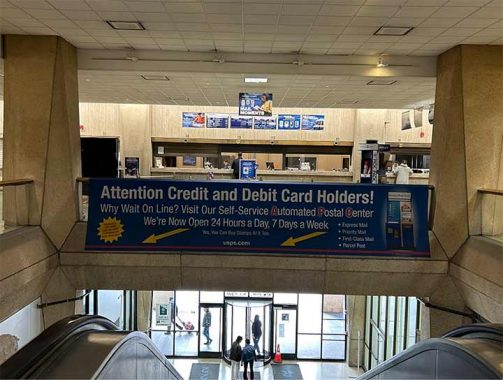
With its monotony of rectangular blocks and numbered streets, any break in this system is deserving of recognition. In the tower’s pedestal is the FDR Post Office, which has a sizable garage that straddles the block with an indoor gas station for the postal trucks. Those who work here have the honor of entering the lobbies of the most exclusive residences on Sutton Place and the corporate towers on Third Avenue.
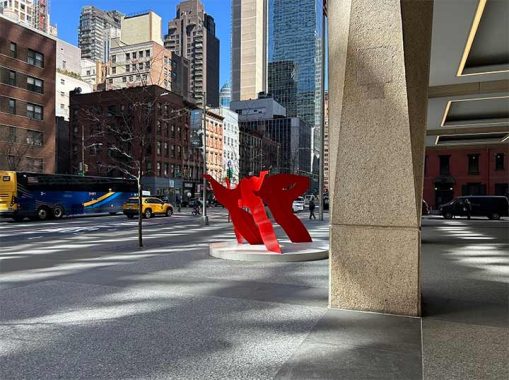
On the Third Avenue side of this tower is Ann Gillen’s 1987 sculpture Flying Red, which seems like an abstraction of a family leaning toward the street to hail a cab. The artist calls it “an array of figures that combine to form a body splitting apart.”
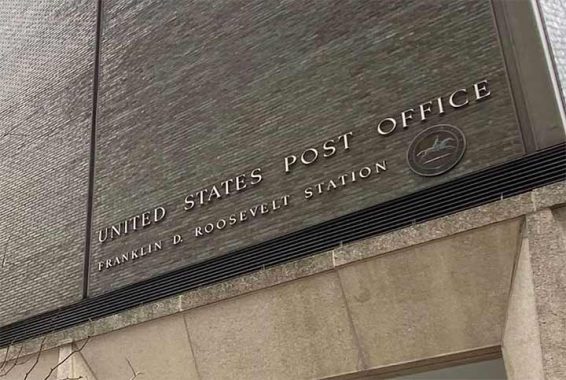
The public facility in this tower is the FDR Post Office, responsible for Turtle Bay, zip code 10022. The 32nd president was born in New York. With many things in the city carrying his name, this post office is perhaps not the best-known but it offers plenty of art inside. The brown brick brutalism offers little to look at but next to the post office’s name is the pre-1970 USPS logo that features a postman riding a horse.
On the escalator upstairs to its cashiers is a bust of FDR by Alan R. Bleich. For a larger bust of this president, there’s one by Jo Davidson at the south tip of Roosevelt Island.
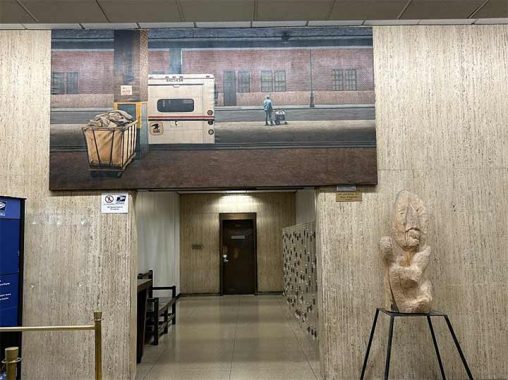
If your mailing address in 10022 is a P.O. Box, you’re greeted by Max Ferguson’s 1987 painting of the loading dock and a sculpture beneath it. The pockmarked marble walls are reminiscent of Lincoln Center, albeit beige rather than white.
Maria Cohen’s works, visually halfway between Rodin and Giacometti, stand alongside the escalator. She also has sculptures at the nearby Grand Central post office. At a time when there is a movement to trim the size and expenses of the federal government, whose idea was it to install art in an otherwise nondescript post office? As the only post office to have sculptures and paintings inside it, it is worthy of mention on Forgotten-NY.
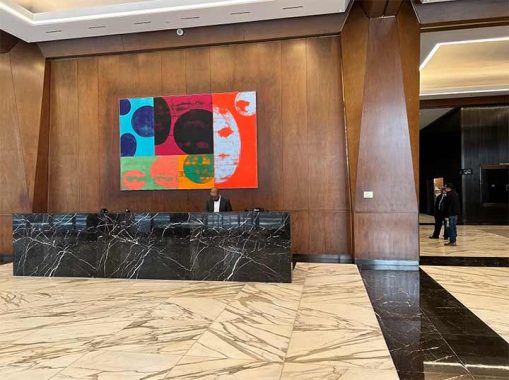
Next door to the post office is the entrance lobby to Vornado’s main offices. Some urban photographers fear the security guard and the unhelpful “May I help you?” as an order to leave. But I calmly walked in and politely told the guard that I teach art history. He obliged by allowing me to photograph Charles Arnoldi’s 2001 acrylic painting Jump Start. Good manners can get you places!
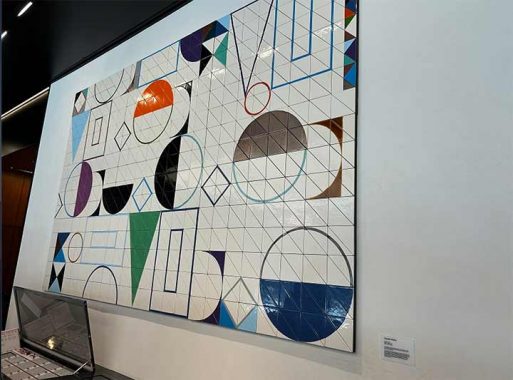
On my way back to the rec center, I walked east on 55th Street, which has the entrance to 909 Third Avenue. A police officer stood watch outside and three security guards staffed the desk in the lobby. Undeterred, I walked in and gave the same introduction. I was allowed to photograph Claudia Wieser’s Display I, completed in 2021. Designed by the famed Skidmore Owings & Merrill, this tower was built around the corner restaurant PJ Clarke’s which stands as an architectural holdout.
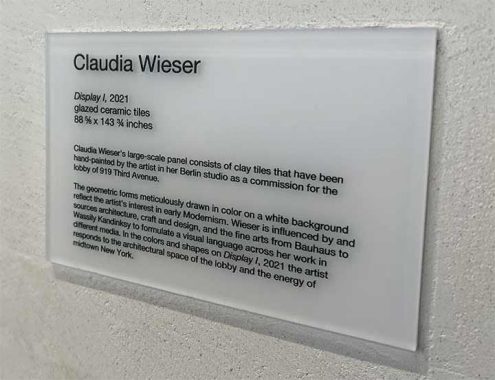
Next to Wieser’s work is an explanatory plaque noting the Bauhaus movement and Wassily Kandinsky as her inspirations. The Russian-born artist’s name was misspelled here and in turn, my name is often misspelled as Kandinsky. I’ve taken a deep dive into my genealogy and we are not even closely related. That one letter makes a huge difference. He descends from Siberian nobility and my roots relate to Belarus.
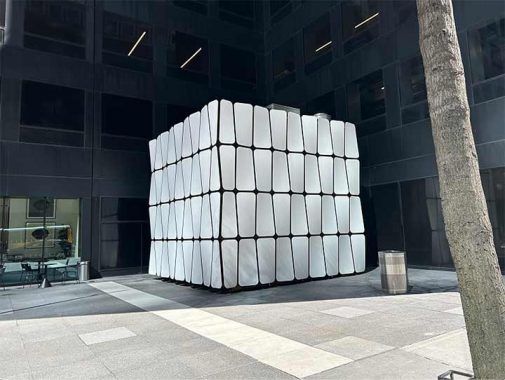
To the right of the entrance to 909 Third Avenue is a cube structure with its own sense of design. Walking around it, I could not find a plaque listing its artist, date, and title. A decade ago, it hosted an Outback Steakhouse take-out which clearly didn’t do as well as its sit-down counterpart.
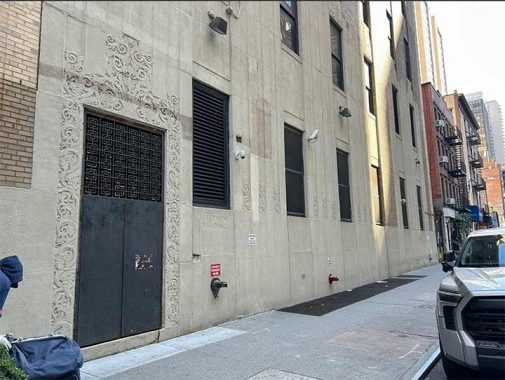
Closer to Second Avenue is a telephone relay building with floral designs resembling those on the Chanin Building. Its main entrance is on the other side at 228 E. 56th Street. Designed by Ralph Walker of the firm of Voorhees, Gmelin & Walker, in his time he was as prolific to telephone buildings across this city as CBJ Snyder was to public schools and Squire Vickers to subway stations. Walker’s work outside the city includes the telephone building in Hempstead.
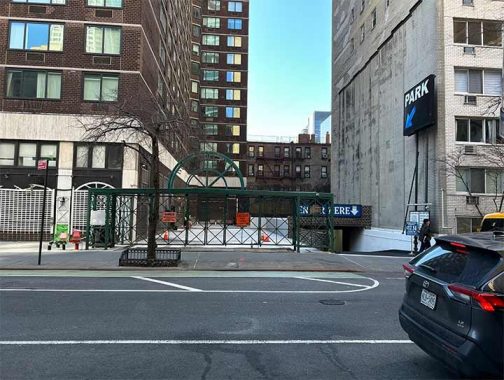
Across the street is a POPS park undergoing reconstruction, framed by a garage entrance and the Brevard co-op tower. Its name sounds like Brevoort, a Dutch colonial family that used to own land further downtown, but I doubt that they’re related.
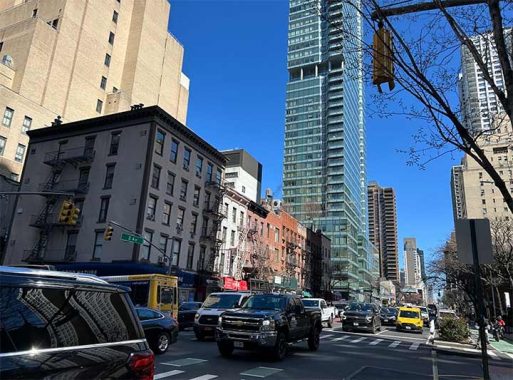
Looking north on Second Avenue is a block of five-story “taxpayer” buildings that will likely have their date with the wrecking crew as the skyline continues to rise. Behind them is Aalto57, a “sculptural apartment building,” as described on its website. Like the nearby Mondrian Tower, its name is a posthumous honor, inspired by the sculptures of Finland’s Alvar Aalto.
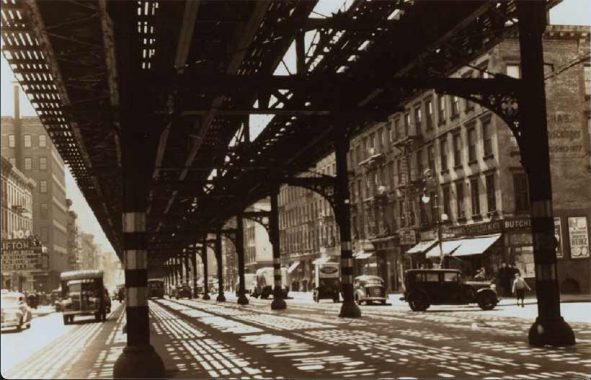
Prior to 1942, an elevated transit line ran above Second Avenue. At the time, it was a working-class route, lined almost entirely by such walk-ups, from Houston Street to Harlem. At the time of its demolition, there were plans for a subway to run on its route, as was done on Sixth Avenue. In 2017, the Second Avenue Subway finally opened between 63rd and 96th streets. As for Turtle Bay, a station is proposed for 55th Street but it will be a lifetime before it becomes reality at his corner.
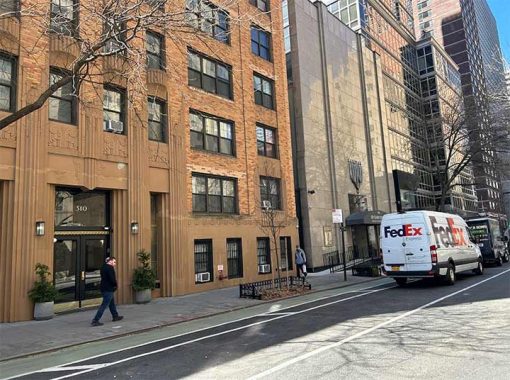
To the east of Second Avenue, 310 E. 54th Street is a true Art Deco apartment, seemingly transported from either Ocean Parkway or Grand Concourse. Next to it is the Conservative Jewish synagogue Or Olam, which to me resembles the ventilation tower of a tunnel but its owners call it a “Deco-style granite facade.”
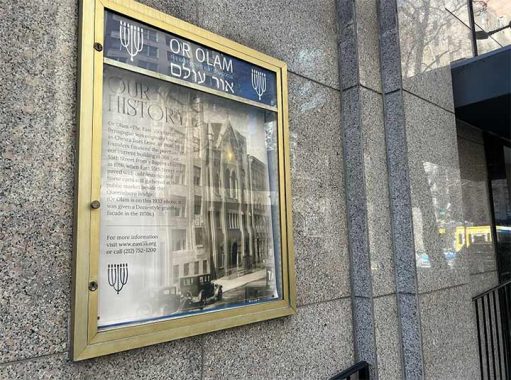
At its entrance is a poster showing how the synagogue appeared before its granite makeover. Prior to serving Jews, this building was a Baptist church. Reaching further back, it was St. Paul’s Methodist Episcopal Church.

At the corner of First Avenue and E. 55th Street, the Roman Catholic Church has a modernist sanctuary honoring St. John the Evangelist. The interior offers more examples of modern art narrating the gospel. The church’s presence on this corner dates to 1879 with the current building completed in the 1970s. Are we still in Turtle Bay, or Sutton Place? The apartment building across from the church carries the name Sutton Collection.
For more on this neighborhood, see Kevin’s essay on 53rd Street, which he wrote in 2005, and his 2017 tour of Turtle Bay.
Sergey Kadinsky is the author of Hidden Waters of New York City: A History and Guide to 101 Forgotten Lakes, Ponds, Creeks, and Streams in the Five Boroughs (2016, Countryman Press), adjunct history professor at Touro University and the webmaster of Hidden Waters Blog.
Check out the ForgottenBook, take a look at the gift shop. As always, “comment…as you see fit.” I earn a small payment when you click on any ad on the site.
3/30/25

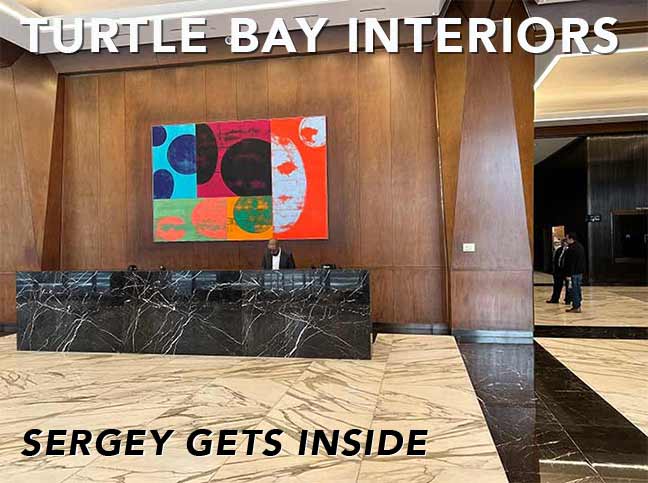
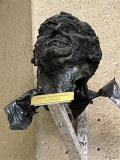
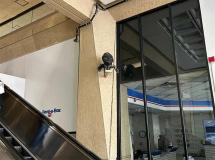
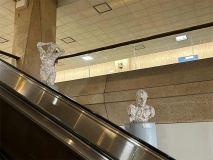
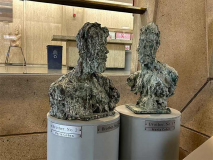
3 comments
Franklin D. Roosevelt was the 32nd President of the United States. Harry S. Truman was the 33rd President.
Geologically speaking, the “pockmarked marble” is not marble at all. It is most likely travertine. Lincoln Center is famous for its Italian travertine facades. Travertine is a sedimentary rock formed from calcium carbonate deposits, resulting in a porous, textured appearance with warm earth tones, while marble is a metamorphic rock formed under heat and pressure, with a denser, smoother surface and a wider range of colors and veining patterns.
St, John the Evangelist is a church?Looks more like headquarters of the Brutalist Corporation